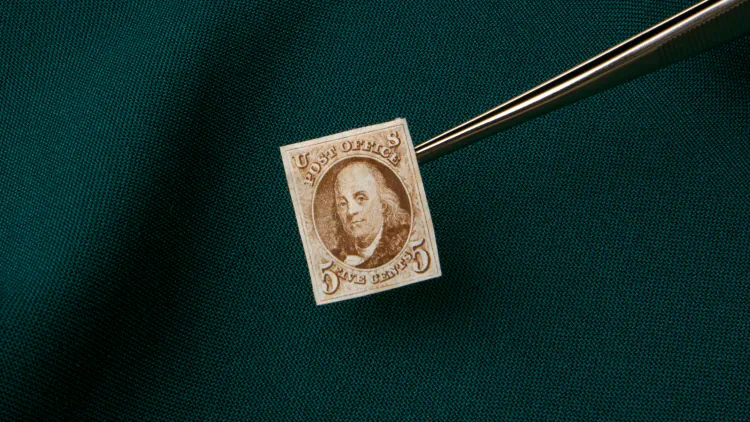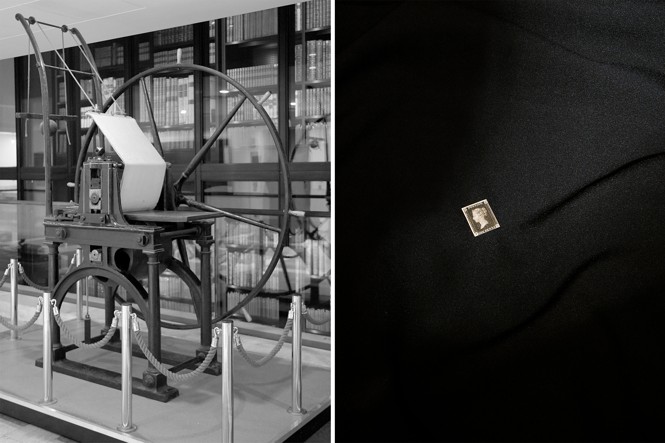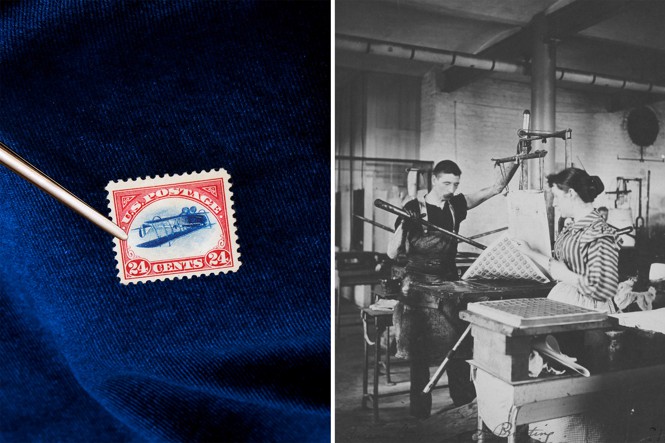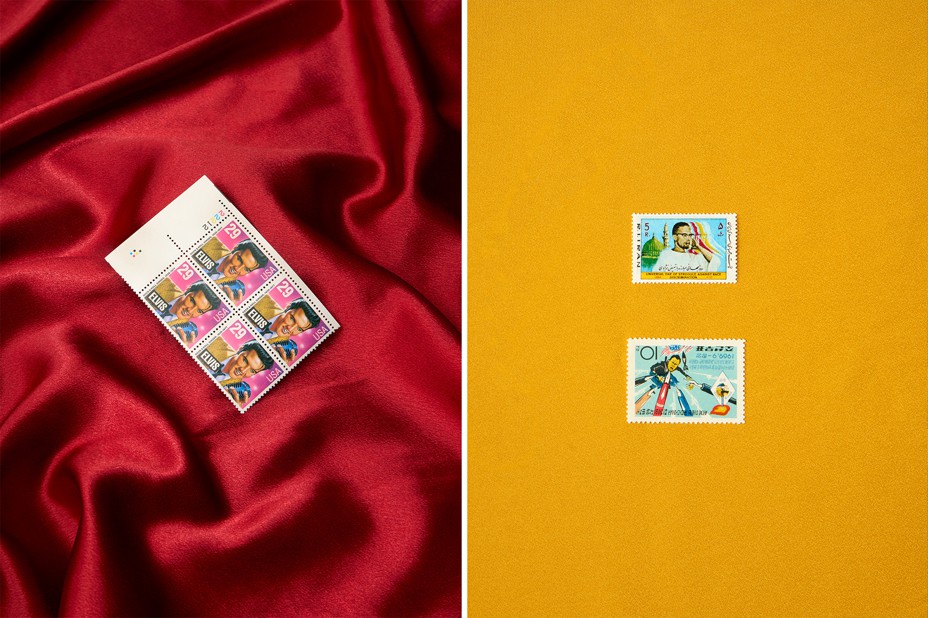Why We Still Use Postage Stamps
The enduring necessity (and importance) of a nearly 200-year-old technology

Photographs by Siqi Li
In a decidedly digital age, the modest postage stamp seems to be slowly vanishing from daily life—no longer ubiquitous in wallets or pocketbooks, useful but maybe not essential.
They’re so overlooked that the comedian Nate Bargatze has an entire bit about how stamps make him “nervous.” “I don’t know how many you’re supposed to put on [a letter],” he says. “And they change the price of stamps, and that’s not in the news, you know? You don’t find that out on Twitter. You have to find out from old people. They’re the only people that know.” (As someone in the news, I am duty bound to report that stamps’ price increased from $0.66 to $0.68 on January 21.)
But stamps aren’t yet entirely anachronistic. Yes, the volume of first-class mail has been on the decline, but the U.S. Postal Service still sells about 12.5 billion stamps annually. Some of this is a matter of taste. “There are certain things where physical mail is still seen as the socially correct way to do things,” says Daniel Piazza, the chief curator of philately at the Smithsonian National Postal Museum, pointing to mailing wedding invitations, birthday notes, and holiday cards.
But stamps serve a purpose that is not merely functional. If you look back far enough, they also tell a story about national identity, and the technological and cultural trajectory of America. Stamps “are both miniature art works and pieces of government propaganda,” Dennis Altman wrote in his 1991 book, Paper Ambassadors: The Politics of Stamps. “They can be used to promote sovereignty, celebrate achievement, define national, racial, religious, or linguistic identity, portray messages or exhort certain behaviour.”
Richard Morel, the curator of the British Library’s Philatelic Collection, put it to me more succinctly: “Stamps democratize our history and culture.” In short, the history of U.S. stamps tells a story of America.
The postage stamp as we know it today is a relatively young technology. Prior to the mid-1800s, “most letters were sent collect, so postage was paid by the recipient of the letter rather than by the sender,” Piazza told me. This turned out to be a very bad business model for the Postal Service. First, it required people to go to their post office to see whether they had mail. In fact, postmasters paid to run ads in local papers listing who had letters to collect so those people would retrieve them. (One true constant across time seems to be that people consider going to the post office a chore.) Then, if there was a letter for someone and they did pick it up, the receiver had to pay the postage, which they sometimes refused to do, given its expense. “So it’s a very cumbersome, sort of expensive system” for both the Postal Service and the receivers of mail, Piazza said.
[Read: One Thousand Stamps, All Different (1939)]
Until a breakthrough in 1840. The U.K. issued the Penny Black, the world’s first prepaid, adhesive stamp. With this stamp, people could send a half-ounce letter for a flat, prepaid rate of one penny. The Penny Black featured the face of Queen Victoria, and, in a sign of the times, some people believed that “licking the back of the queen’s head was undignified, if not potentially treasonous,” Altman wrote in his book. On a recent visit to the British Library, I was able to see the last remaining press of the type that printed the Penny Black. Displayed on the library’s upper-ground floor, the machine—which was smaller than I had imagined, given its function—looked as delicate as an antiquity of the Industrial Revolution can, with its large spindle, rope pulleys, and iron weights.

This British innovation in stamp production set the path for other countries to follow. In the 1840s and ’50s, several other nations developed their own postage stamps. The U.S. issued its first ones on July 1, 1847: a five-cent stamp featuring Benjamin Franklin, the country’s first postmaster general, and a 10-cent stamp featuring George Washington. (Washington, distinguished in so many ways, also has the distinction of having more appearances on U.S. stamps than anyone else.)
The start of stamps in the U.S. was an unheralded affair. A postmaster in Maine mailed a letter—without a stamp, postage due—to the postmaster general to inquire whether the stamps his office had received were “genuine,” according to Smithsonian Magazine. But by 1856, all mail required federal, prepaid postage stamps, and we largely entered the state of postage stamps as we know them today. Or, as Morel put it, their invention “triggered our information revolution.”
Stamp design, however, took a little longer to develop. For decades, American stamps followed the aesthetics of coin-face design, that is, profile drawings of heads of state. In our case, primarily dead presidents: George Washington, Thomas Jefferson, Andrew Jackson. The U.S. didn’t begin issuing commemorative stamps until 1893, timed to the World’s Fair in Chicago, with a series of 16 stamps celebrating the 400th anniversary of Columbus’s voyage to the New World. Included in the series was a depiction of Queen Isabella of Spain, making her the first woman featured on a U.S. stamp. (The first American woman on a stamp was Martha Washington, in 1902.)
In the 130 years since that first commemorative stamp, hundreds and hundreds more designs have been issued. U.S. postage stamps have celebrated momentous events, such as the 1932 Winter Olympics in Lake Placid New York, home of the first U.S. Winter Olympics Games, and the moon landing, in 1969. There have been many stamp firsts: the first Hispanic American (Admiral David Farragut, 1903), the first Native American (Pocahontas, 1907), the first African American (Booker T. Washington, 1940). Some stamps impart social messages: Prevent Drug Abuse (1971) or Alcoholism: You Can Beat It (1981). They’ve even been used to fund causes. The Breast Cancer Research semipostal has sold more than 1 billion stamps since it was first issued, in 1998, and has raised millions of dollars for the cause.
“If you compare some of the American stamp designs … to other countries’, they’re incredibly progressive much earlier on,” Morel said. There’s the Black Heritage Series, which began in 1978 with an image of Harriet Tubman and still runs today with annual new releases. Helen Keller and Anne Sullivan were commemorated on a stamp in 1980. Even designs that might now be seen as dated or insensitive were bold in their own time. In 1969, the U.S. Postal Service issued a stamp that featured an image of a young child gradually emerging out of a wheelchair. The language on the stamp reads, Hope for the crippled. “The language is now problematic,” Morel said, “but it’s the intent that underlies the stamp design, which is actually a positive one.”
These design decisions are not made lightly. In 1957, the Postal Service created the Citizens’ Stamp Advisory Committee, which consists of a group of people from across disciplines who consider stamp recommendations from the public. Anyone can suggest any subject to the council, which will weigh the recommendation so long as it meets its healthy list of criteria—for example, the design should honor a subject or a figure that made a significant contribution to American life, and the commemorated can’t be a living person.

It’s a deliberative process that can take several years—and for good reason. Nearly any stamp design is certain to irritate someone. In the early 1990s, when the Postal Service announced that it would be releasing a stamp featuring Elvis, some Americans were scandalized. They couldn’t fathom the idea of honoring someone who had addiction issues and was once considered too sexy for broadcast television. “I was appalled to see that a picture of Elvis Presley is being considered for a postage stamp,” one person wrote in a letter to the editor of the St. Louis Post-Dispatch in 1992. “The picture on a postage stamp should be someone or something of historical significance or an individual who has made an extraordinary contribution to the well-being of the human race … If Presley appears on a stamp, the postmaster general should be fired immediately.” The Postal Service won the day; the Elvis stamp is widely considered the most popular commemorative stamp in U.S. history. The decision to put Bugs Bunny on a stamp was also met with mild indignation. “That one probably didn’t go over as well with the serious stamp collectors,” says Jay Bigalke, the editor in chief of Linn’s Stamp News. People used it as an excuse to “write to the Postal Service and say, ‘If you can issue a stamp for Bugs Bunny, you can issue a stamp for fill-in-the-blank.’”
A reason these design choices are so freighted is that they have broad, international reach. “Trivial as they may seem, [stamps] are objects that are extremely dispersed both domestically and abroad, and which allow governments to propagate widely the official culture of a given state,” Altman wrote. Said another way, stamps let officials tell the story they want to tell. President Franklin D. Roosevelt, a stamp collector himself, “nosed his way into stamp design, even sketching them out on a napkin and passing it along to the postmaster general at the time,” Bigalke told me. After Roosevelt signed the National Industrial Recovery Act, he asked for a stamp promoting the law to be issued. “He just recognized the importance of the postage stamp and conveying a message,” Bigalke said.
Other countries use their stamps to tell stories too, and sometimes those stories are deeply influenced by the United States. A number of African countries have released stamps featuring Martin Luther King Jr., for example, a testament to King’s international importance and popularity. The Apollo 11 mission has been featured on more than 50 stamps in other countries. A stamp issued by Iran in 1984 featured Malcolm X. American pop culture has also infiltrated international postage stamps. In the Caribbean, St. Vincent and the Grenadines has featured both Elvis and Michael Jackson on its stamps. (Jackson has not been featured on an American stamp.)
Stamps are also used for more expressly political or propagandist purposes. In 1969, North Korea issued a stamp called “International Conference of Journalists Against US Imperialism,” showing several pens attacking President Richard Nixon. “The very fact that [North Korea] uses stamps as a medium to attack America is, again, proof [of] the value of stamps,” Morel said. “Because if there was no value, why bother?”
More recently, Ukraine used its stamp program as a sort of hearts-and-minds campaign. “When the invasion and the war broke out, they issued a postage stamp showing a soldier flipping off the battleship” off of Snake Island, Bigalke said. Ukraine has “been using stamps as a rallying cry in the country in a much more powerful way than any other country really has with their postage stamps,” he told me. “A lot of people have bought the stamps to help support Ukraine.”
Stamps have also been used as a sort of bilateral foreign-relations tool. A stamp commemorating joint Soviet-American efforts in space exploration was released in 1975, during the Cold War. And the U.S. and Australia jointly released stamps celebrating the latter’s bicentenary, in 1988.
Perhaps the most famous American stamp design is one the U.S. Postal Service never wanted to release. In 1918, the department issued its first airmail stamp, which featured a Curtiss Jenny biplane. Because of its two-color design, the stamp had to go through the press twice. And at some point in the printing, one of the plates was turned upside down. This run resulted in nine misprinted 100-stamp sheets. Eight of them were found and destroyed on the printing floor, but one misprinted sheet of the stamp—now known as the Inverted Jenny—found its way to the public. (In 1939, this magazine referred to such misprints as “philatelic romances.”) The Inverted Jenny has since become one of the most highly prized stamps for collectors and is a small pop-culture phenomenon. It was briefly referenced in the film Brewster’s Millions and in a joke at Homer’s expense in The Simpsons. Last year, a single Inverted Jenny stamp sold for a little more than $2 million.
Stamps provide “an amazing body of material to study the history of communication, art, design, but also humanity,” Morel said. And this study started essentially on the very first day of the modern postage stamp’s existence. The oldest surviving stamp collection dates back to 1855, by a collector from Belgium who started amassing the stamps to learn geography.
In 1943, in the midst of World War II, The Atlantic published a sort of defense of the hobby in its February issue. “So stamp collecting. It’s a vice, but most pleasant,” wrote Henry Bellamann, a poet and an author, in the article “Stamps for Me.” He later continued, “The stress of the day in which we are living is unbelievably great. We have need of releases through simple pleasures.”
Seeing stamps through the prism of history made a recent visit to my local, fluorescently lit post office edge just barely into exciting territory. I had gone to return a package and thought I might buy some stamps. A gentleman ahead of me in line asked about the particular design I wanted, and I overheard the teller say that it had sold out. So when I returned home, I decided to buy some stamps online. Scrolling through the gallery, I selected some Our Lady of Guápulo holiday stamps (issued 2020) and some Piñatas! stamps (issued 2023) to attach to invites for a party. I could just send an email invite, but knowing that nearly everyone’s mood lifts when they receive actual letters, it only feels right to choose the mailbox over the inbox.
Supported by the British Library Eccles Institute for the Americas Phil Davies Fellowship.
What's Your Reaction?




















